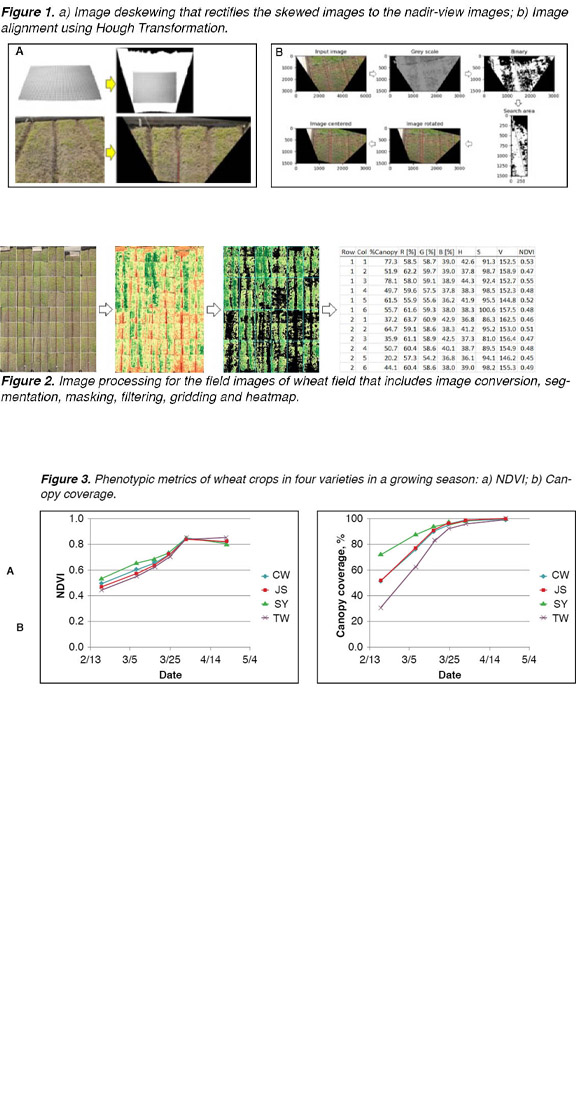Research Project
High Throughput Image Analytics for Crop Phenotyping
Investigators: James Kim, Myungna Shin, Jihyun Lee, Weontai Jeon, Seungho Cho
Funding Agency: USDA-ARS under project 6066-13000-005-000D
Date: 2021
Project Summary
Introduction
Image-based phenotyping provides the most promising tool for consistent quantitative measurement of phenotypic metrics. High throughput phenotyping is particularly desired to provide a timely process of the breeding pipeline. Challenges remain to address a seamless integration of sensor, processing, analytics, and data management for the accuracy and consistency. The goal of the study is to develop high throughput image analytics to implement field mapping and plant phenotyping using a handheld camera, e.g., smart phone. Specific objectives are to develop algorithm to transform raw images into geo-rectified images using row detection and design software to automate image alignment and stitching to extract plot-level metrics.
Materials and Methods
Experiment was conducted in international collaboration with National Institute of Crop Science in Korea on wheat crop field with four different varieties (Shinyoung (SY), Joseong (JS), Taewoo (TW), and Cheongwoo (CW)). The plants were seeded at 196 lb/ac on October 22, 2020 on three replicated subfields located at 37° 27’ N, 126° 99’ E. Each subfield was sized to 7,611 ft2 (43 ft × 177 ft) and split to four plots, creating total 12 plots. Images were collected during the spring of 2021 on 2/19, 3/8, 3/17, 3/25, 4/2, and 4/22 by a field operator using a smart phone camera that was mounted on a selfie stick to reach 8 ft high and capture oblique view (i.e., skewed) images (Figure 1a). Image collection was triggered in 23-ft interval at four locations per plot with 20% overlaps. When deskewed images are stitched together, misaligned tile images occur due to an acquisition inconsistency which causes errors in gridding analysis and thus must be rectified to align the crop rows. Geometric calibration was developed by detecting a row line using Hough Transformation and rotating the image to make the line vertical (Figure 1b). A GUIbased Python application, iStitch, was developed to implement a series of image processing algorithms from image loading to metrics extraction through deskewing, row detection, image alignment, and stitching. The aligned tile images are mosaicked to create a stitched field image and further processed for plot-level metrics extraction.
Results and Discussion
The image was converted from RGB to HSV and segmented in hue image band with pre-defined thresholding values. A 4 × 6 grid was applied to cover 24 plot boundaries. Each sub-grid, i.e., ROI, was individually processed to calculate vegetation and leaf area indexes (LAI) per plot. Figure 2 illustrates the image processing from the field image to the gridded vegetation image. The field images were analyzed for temporal responses of phenotypic metrics of four wheat varieties during the growing season. Overall, SY variety showed the best performance in both NDVI and canopy coverage throughout the season especially in early stages, whereas the TW variety performed the lowest with a difference of average NDVI = 0.08 and 21% canopy coverage lower than those of SY variety (Figure 3a). The canopy coverage was significantly different between SY and TW varieties (Figure 3b).
Conclusion
Four wheat varieties were tested to monitor the plant growth conditions using an image- based phenotyping approach. GUI-based image stitching software was developed to allow the user to automate the stitching process and successfully delivered the stitched images through deskewing, geometric rectification, trimming, and resizing. The proposed approach of the stitching and gridding was applied on the skewed images acquired by a smart phone camera in the study but can be directly used for images acquired in greenhouse or fields from a grid of stationary or mobile cameras.
Project Photos

Find Research
By Crop Type
By Topic
Contact NCAAR
General Information
Kaye Sullivan
vfs23@msstate.edu
662.390.8510
F:662.390.8501
Showcase Demo
Drew Gholson, Coordinator
drew.gholson@msstate.edu
662.390.8505
Himmy Lo
himmy.lo@msstate.edu
662.390.8509

